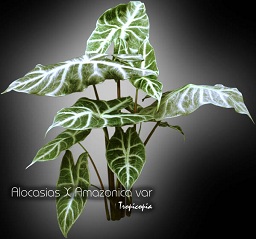Table of contents
Elephant ear

Latin Name: Alocasias X Amazonica var
Category: Other
Family: Araceae
Origin: Hybrid
Climate: Tropical humid
Growing Zones: 11
Care Instructions
The Elephant ear (Alocasias X Amazonica var) is a tropical humid plant that originates from Hybrid. This other plant belongs to the Araceae family and is well-suited for growing in USDA zones 11.
Complete Care Guide for Elephant Ear (Alocasias X Amazonica var)
Watering Requirements
The Elephant Ear plant, known scientifically as Alocasias X Amazonica var, thrives in consistently moist soil. It is essential to water the plant regularly, ensuring that the top inch of soil remains damp but not soggy. Overwatering can lead to root rot, so it’s crucial to allow excess water to drain away. During the growing season, typically spring and summer, you may need to water more frequently, about once a week, while in the dormant winter months, reduce watering to every two weeks. Always check the moisture level by inserting your finger into the soil; if it feels dry, it’s time to water.
Light Conditions
Elephant Ear plants prefer bright, indirect light to thrive. Direct sunlight can scorch their large, lush leaves, leading to unsightly brown spots. Ideally, place your Elephant Ear near a window with filtered light or in a well-lit room. If you notice the leaves stretching towards the light, it may indicate that the plant is not receiving enough light. Conversely, if the leaves are turning yellow, it could be a sign of too much direct sunlight. For optimal growth, aim for a balance of bright, indirect light for at least 6-8 hours a day.
Soil Preferences
Elephant Ear plants thrive in well-draining, rich, and organic soil. A potting mix that includes peat moss, perlite, and compost is ideal, as it retains moisture while allowing excess water to escape. The pH level of the soil should be slightly acidic to neutral, around 5.5 to 7.0. To promote healthy growth, consider fertilizing your Elephant Ear every 4-6 weeks during the growing season with a balanced, water-soluble fertilizer. This will provide the necessary nutrients to support the plant’s vigorous growth and vibrant foliage.
Pests and Diseases
Common pests that may affect Elephant Ear plants include spider mites, aphids, and mealybugs. Regularly inspect the undersides of the leaves for signs of infestation, such as webbing or sticky residue. If you notice pests, treat the plant with insecticidal soap or neem oil, ensuring to cover all leaf surfaces. Additionally, Elephant Ear plants can be susceptible to diseases like root rot and leaf spot, often caused by overwatering or poor air circulation. To prevent these issues, ensure proper watering practices and provide adequate spacing between plants to promote airflow.
Special Care Tips
To keep your Elephant Ear plant healthy and thriving, consider the following special care tips: First, maintain humidity levels around the plant, as it enjoys a humid environment. You can achieve this by misting the leaves regularly or placing a humidifier nearby. Additionally, during the winter months, reduce watering and keep the plant in a warmer area to prevent cold drafts. If your Elephant Ear grows too large, you can prune the leaves to maintain its size and shape. Finally, repot the plant every couple of years to refresh the soil and provide more space for growth, ensuring it continues to flourish in your home or garden.








